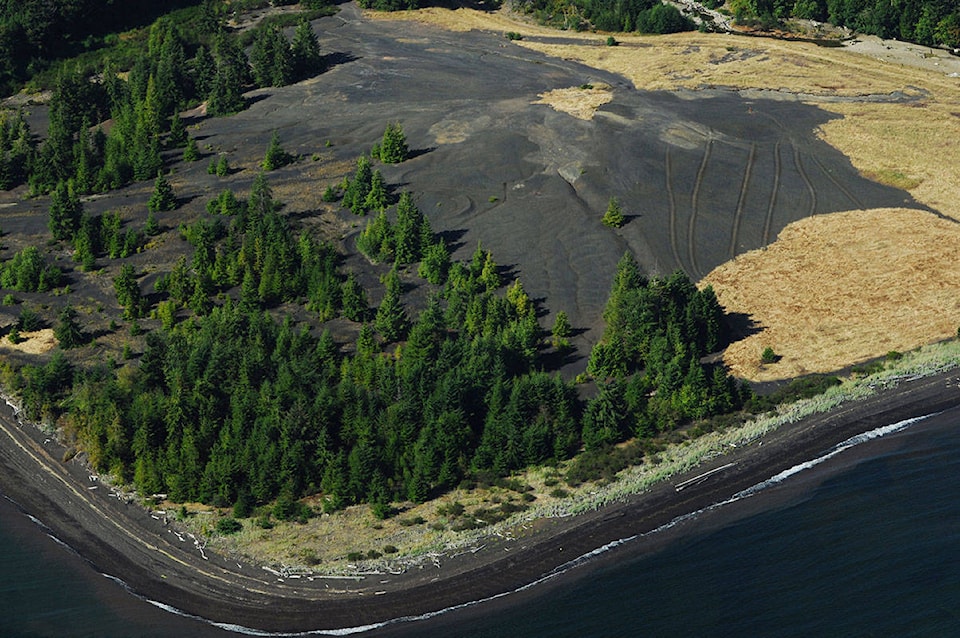A draft plan for the remediation of the contaminated Union Bay coal hills should be submitted to the province this June, and the information could be public by the fall, according to a representative from West Fraser Mills.
Although most of the information contained in the agreement between West Fraser and the provincial government over the coal hills’ clean-up is still confidential, representatives from the two bodies presented an update on the issue at the Comox Valley Regional District’s April 24 board meeting.
Read More: West Fraser Timber to supply engineered cover for Union Bay coal hills
Duncan Williams, the executive director of crown land opportunities for the Ministry of Forests, Lands, Natural Resource Operations and Rural Development, (FLNRORD) said his department will review West Fraser’s draft plan when it is submitted later this spring. If happy with it, he said they will send the plan to the Ministry of Environment — the regulator — for further scrutiny.
“It’s not until [Ministry of Environment] signs off on it and improves on it that we’ll know what the final design is,” he said.
West Fraser leases a portion of the Union Bay coal hills from the Crown. Pending the regulator’s approval, the forestry company plans to supply an engineered membrane that will cover the entire contaminated site. The membrane will include a layer of soil on top of it, about a metre or two deep.
The engineered cover is hoped to impede water access to the coal pile, reducing acid rock drainage and the release of metals to the environment.
Now that the provincial government owns the land, it will be responsible for monitoring and maintaining the coal hills following its remediation.
“Over time, our experience with remediated sites is that they self-remediate,” said Williams. “That’s part of the monitoring [we’ll do] to make sure it’s in effect. We’re going to monitor the foreshore as well to make sure it’s working. If it’s not working, we’ll [install] a water treatment plant.”
“Our long-term goal is to keep it vacant Crown land,” added Williams. “Make sure there are no trees on it, and minimal use from the public on it. We don’t want motorbikes riding over the top of it.”
Design phase
According to West Fraser environmental affairs manager Cindy MacDonald, the forestry company is currently in the design phase. She said capping the contaminated area is the standard practice for remediating contaminated sites such as the one in Union Bay.
“You couldn’t move that pile because you’d open it up and potentially have a significant environmental problem once you open it up to the water and the air,” she said.
MacDonald and Williams said the likely plan is to apply a membrane similar to the one used at Yanks Peak in the Kootenays — an engineered cap with a lifespan between 50 and 100 years.
MacDonald said the forestry company is paying for the design and installation of the cover and said remediation could take two or three years to be completed.
“Depending on when we get approval to go ahead with the remediation plan, it will probably be the following year,” she said.
After the membrane is installed, West Fraser will surrender its portion of the coal hills to the province.
Remediation years in the making:
The B.C. government has recognized the Union Bay coal hills as a “priority contaminated site” since 2012. Negotiations over the need for its remediation have gone on for over a decade.
Read More: Union Bay coal hills on priority contaminated site list
Much of the coal hills was previously owned by development company Kensington Union Bay Properties. The developer sold the land to the province last year for $1, to the surprise of some Union Bay landowners.
Read More: Kensington Island Properties sells 28 acres of contaminated Union Bay land to the province
The Union Bay coal hills were originally used by Canadian Collieries (Dunsmuir) Ltd. as a washing and load-out facility for coal coming from the Cumberland mines. The hills’ contamination is due to residue from the industrial operations undertaken there.
